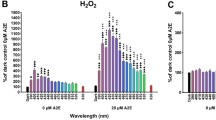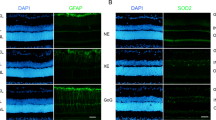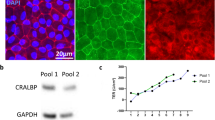Abstract
The blue-light hazard (BLH) has raised concerns with the increasing applications of white light-emitting diodes (LEDs). Many researchers believed that the shorter wavelength or more light components generally resulted in more severe retinal damage. In this study, based on the conventional phosphor-coated white LED, we added azure (484 nm), cyan (511 nm), and red (664 nm) light to fabricate the low-hazard light source. The low-hazard light sources and conventional white LED illuminated 68 Sprague–Dawley (SD) rats for 7 days. Before and after light exposure, we measured the retinal function, thickness of retinal layers, and fundus photographs. The expression levels of autophagy-related proteins and the activities of oxidation-related biochemical indicators were also measured to investigate the mechanisms of damaging or protecting the retina. With the same correlated color temperature (CCT), the low-hazard light source results in significantly less damage on the retinal function and photoreceptors, even if it has two times illuminance and blue-light hazard-weighted irradiance (\({E}_{B}\)) than conventional white LED. The results illustrated that \({E}_{B}\) proposed by IEC 62471 could not exactly evaluate the light damage on rats’ retinas. We also figured out that more light components could result in less light damage, which provided evidence for the photobiomodulation (PBM) and spectral opponency on light damage.
Graphical abstract








Similar content being viewed by others
Data availability
Data are available upon request directed to the corresponding author.
References
Hye Oh, J., Ji Yang, S., & Rag Do, Y. (2014). Healthy, natural, efficient and tunable lighting: four-package white LEDs for optimizing the circadian effect, color quality and vision performance. Light Science and Applications, 3(2), e141–e141. https://doi.org/10.1038/lsa.2014.22
Cho, J., Park, J. H., Kim, J. K., & Schubert, E. F. (2017). White light-emitting diodes: History, progress, and future. Laser and Photonics Reviews, 11(2), 1600147. https://doi.org/10.1002/lpor.201600147
Behar-Cohen, F., Martinsons, C., Viénot, F., Zissis, G., Barlier-Salsi, A., Cesarini, J. P., Enouf, O., Garcia, M., Picaud, S., & Attia, D. (2011). Light-emitting diodes (LED) for domestic lighting: Any risks for the eye? Progress in Retinal and Eye Research, 30(4), 239–257. https://doi.org/10.1016/j.preteyeres.2011.04.002
IEC. (2006). IEC 62471: 2006 photobiological safety of lamps and lamp systems. https://webstore.iec.ch/publication/7076
Ouyang, X., Yang, J., Hong, Z., Wu, Y., Xie, Y., & Wang, G. (2020). Mechanisms of blue light-induced eye hazard and protective measures: A review. Biomedicine and Pharmacotherapy, 130, 110577. https://doi.org/10.1016/j.biopha.2020.110577
Tao, J.-X., Zhou, W.-C., & Zhu, X.-G. (2019). Mitochondria as potential targets and initiators of the blue light hazard to the retina. Oxidative Medicine and Cellular Longevity, 2019, 1–20. https://doi.org/10.1155/2019/6435364
Kutsyr, O., Sánchez-Sáez, X., Martínez-Gil, N., de Juan, E., Lax, P., Maneu, V., & Cuenca, N. (2020). Gradual increase in environmental light intensity induces oxidative stress and inflammation and accelerates retinal neurodegeneration. Investigative Opthalmology and Visual Science, 61(10), 1. https://doi.org/10.1167/iovs.61.10.1
de Gálvez, E. N., Aguilera, J., Solis, A., de Gálvez, M. V., de Andrés, J. R., Herrera-Ceballos, E., & Gago-Calderon, A. (2022). The potential role of UV and blue light from the sun, artificial lighting, and electronic devices in melanogenesis and oxidative stress. Journal of Photochemistry and Photobiology B: Biology, 228, 112405. https://doi.org/10.1016/j.jphotobiol.2022.112405
Yoshida, A., Yoshino, F., Makita, T., Maehata, Y., Higashi, K., Miyamoto, C., Wada-Takahashi, S., Takahashi, S., Takahashi, O., & Lee, M. C. (2013). Reactive oxygen species production in mitochondria of human gingival fibroblast induced by blue light irradiation. Journal of Photochemistry and Photobiology B: Biology, 129, 1–5. https://doi.org/10.1016/j.jphotobiol.2013.09.003
Shang, Y. M., Wang, G. S., Sliney, D. H., Yang, C. H., & Lee, L. L. (2017). Light-emitting-diode induced retinal damage and its wavelength dependency in vivo. International Journal of Ophthalmology, 10(2), 191–202. https://doi.org/10.18240/ijo.2017.02.03
Ziółkowska, N., Chmielewska-Krzesińska, M., Vyniarska, A., & Sienkiewicz, W. (2022). Exposure to blue light reduces melanopsin expression in intrinsically photoreceptive retinal ganglion cells and damages the inner retina in rats. Investigative Opthalmology and Visual Science, 63(1), 26. https://doi.org/10.1167/iovs.63.1.26
Nakamura, M., Yako, T., Kuse, Y., Inoue, Y., Nishinaka, A., Nakamura, S., Shimazawa, M., & Hara, H. (2018). Exposure to excessive blue LED light damages retinal pigment epithelium and photoreceptors of pigmented mice. Experimental Eye Research, 177, 1–11. https://doi.org/10.1016/j.exer.2018.07.022
Jin, M., Li, X., Yan, F., Chen, W., Jiang, L., & Zhang, X. (2021). The effects of low-color-temperature dual-primary-color light-emitting diodes on three kinds of retinal cells. Journal of Photochemistry and Photobiology B, 214, 112099. https://doi.org/10.1016/j.jphotobiol.2020.112099
Xie, C., Zhu, H., Chen, S., Wen, Y., Jin, L., Zhang, L., Tong, J., & Shen, Y. (2020). Chronic retinal injury induced by white LED light with different correlated color temperatures as determined by microarray analyses of genome-wide expression patterns in mice. Journal of Photochemistry and Photobiology B, 210, 111977. https://doi.org/10.1016/j.jphotobiol.2020.111977
Shang, Y. M., Wang, G. S., Sliney, D., Yang, C. H., & Lee, L. L. (2014). White light-emitting diodes (LEDs) at domestic lighting levels and retinal injury in a rat model. Environmental Health Perspectives, 122(3), 269–276. https://doi.org/10.1289/ehp.1307294
Tanito, M., Kaidzu, S., & Anderson, R. E. (2006). Protective effects of soft acrylic yellow filter against blue light-induced retinal damage in rats. Experimental Eye Research, 83(6), 1493–1504. https://doi.org/10.1016/j.exer.2006.08.006
Liu, X., Zhou, Q., Lin, H., Wu, J., Wu, Z., Qu, S., & Bi, Y. (2019). The protective effects of blue light-blocking films with different shielding rates: A rat model study. Translational Vision Science and Technology, 8(3), 19. https://doi.org/10.1167/tvst.8.3.19
Narimatsu, T., Ozawa, Y., Miyake, S., Kubota, S., Yuki, K., Nagai, N., & Tsubota, K. (2014). Biological effects of blocking blue and other visible light on the mouse retina. Clinical and Experimental Ophthalmology, 42(6), 555–563. https://doi.org/10.1111/ceo.12253
Garcı, D., Vicente-tejedor, J., Marchena, M., Ramı, L., Sa, C., Villa, P. D., & Germain, F. (2018). Removal of the blue component of light significantly decreases retinal damage after high intensity exposure. PLoS ONE, 13(3), 1–18. https://doi.org/10.1371/journal.pone.0194218
Huang, H.-P., Wei, M., & Ou, L.-C. (2018). White appearance of a tablet display under different ambient lighting conditions. Optics Express, 26(4), 5018–5030. https://doi.org/10.1364/oe.26.005018
Ohno, Y. (2014). Practical use and calculation of CCT and Duv. LEUKOS Journal of Illuminating Engineering Society of North America, 10(1), 47–55. https://doi.org/10.1080/15502724.2014.839020
Chen, H., Zhu, R., Lee, Y.-H., & Wu, S.-T. (2016). Correlated color temperature tunable white LED with a dynamic color filter. Optics Express, 24(6), A731. https://doi.org/10.1364/OE.24.00A731
Leung, T. W., Li, R. W. H., & Kee, C. S. (2017). Blue-light filtering spectacle lenses: Optical and clinical performances. PLoS ONE, 12(1), 1–15. https://doi.org/10.1371/journal.pone.0169114
Meng, Q., Lian, Y., Jiang, J., Wang, W., Hou, X., Pan, Y., Chu, H., Shang, L., Wei, X., & Hao, W. (2018). Blue light filtered white light induces depression-like responses and temporary spatial learning deficits in rats. Photochemical and Photobiological Sciences, 17(4), 386–394. https://doi.org/10.1039/C7PP00271H
Nie, J., Chen, Z., Jiao, F., Chen, Y., Zhan, J., Chen, Y., Pan, Z., Kang, X., Wang, Y., Wang, Q., Dang, W., Dong, W., Zhou, S., Yu, X., Tong, Y., Zhang, G., & Shen, B. (2022). Utilization of far-red LED to minimize blue light hazard for dynamic semiconductor lighting. LEUKOS. https://doi.org/10.1080/15502724.2022.2043163
Heinig, N., Schumann, U., Calzia, D., Panfoli, I., Ader, M., Schmidt, M. H. H., Funk, R. H. W., & Roehlecke, C. (2020). Photobiomodulation mediates neuroprotection against blue light induced retinal photoreceptor degeneration. International Journal of Molecular Sciences, 21(7), 2370. https://doi.org/10.3390/ijms21072370
York, N., Geneva, I. I., Ave, I., Red, C., & Prize, N. (2016). Photobiomodulation for the treatment of retinal diseases: A review. International Journal of Ophthalmology, 9(1), 145–152. https://doi.org/10.18240/ijo.2016.01.24
Rono, C., & Oliver, T. R. (2020). Near infrared light exposure is associated with increased mitochondrial membrane potential in retinal pigmented epithelial cells. Photochemical and Photobiological Sciences, 19(10), 1455–1459. https://doi.org/10.1039/D0PP00168F
Eells, J. T., Henry, M. M., Summerfelt, P., Wong-Riley, M. T. T., Buchmann, E. V., Kane, M., Whelan, N. T., & Whelan, H. T. (2003). Therapeutic photobiomodulation for methanol-induced retinal toxicity. Proceedings of the National Academy of Sciences of the United States of America, 100(6), 3439–3444. https://doi.org/10.1073/pnas.0534746100
Heiskanen, V., & Hamblin, M. R. (2018). Photobiomodulation: Lasers vs. light emitting diodes? Photochemical and Photobiological Sciences, 17(8), 1003–1017. https://doi.org/10.1039/C8PP00176F
Shang, Y. M., Lee, L. L., Hwang, J. M., Wang, G. S., & Cheng, C. P. (2017). Assessing retinal hazardous effects from phosphor converted light emitting diode (LED) lighting with different Correlated Color Temperature (CCT). Key Engineering Materials, 730, 112–118. https://doi.org/10.4028/www.scientific.net/KEM.730.112
Figueiro, M. G., Bullough, J. D., Parsons, R. H., & Rea, M. S. (2004). Preliminary evidence for spectral opponency in the suppression of melatonin by light in humans. NeuroReport, 15(2), 313–316. https://doi.org/10.1097/00001756-200402090-00020
Figueiro, M. G., Bierman, A., & Rea, M. S. (2008). Retinal mechanisms determine the subadditive response to polychromatic light by the human circadian system. Neuroscience Letters, 438(2), 242–245. https://doi.org/10.1016/j.neulet.2008.04.055
Rea, M. S., Figueiro, M. G., Bullough, J. D., & Bierman, A. (2005). A model of phototransduction by the human circadian system. Brain Research Reviews, 50(2), 213–228. https://doi.org/10.1016/j.brainresrev.2005.07.002
Jaadane, I., Villalpando Rodriguez, G. E., Boulenguez, P., Chahory, S., Carré, S., Savoldelli, M., Jonet, L., Behar-Cohen, F., Martinsons, C., & Torriglia, A. (2017). Effects of white light-emitting diode (LED) exposure on retinal pigment epithelium in vivo. Journal of Cellular and Molecular Medicine, 21(12), 3453–3466. https://doi.org/10.1111/jcmm.13255
Xia, H., Hu, Q., Li, L., Tang, X., Zou, J., Huang, L., & Li, X. (2019). Protective effects of autophagy against blue light-induced retinal degeneration in aged mice. Science China Life Sciences, 62(2), 244–256. https://doi.org/10.1007/s11427-018-9357-y
Huang, C., Zhang, P., Wang, W., Xu, Y., Wang, M., Chen, X., & Dong, X. (2014). Long-term blue light exposure induces RGC-5 cell death in vitro: Involvement of mitochondria-dependent apoptosis, oxidative stress, and MAPK signaling pathways. Apoptosis, 19(6), 922–932. https://doi.org/10.1007/s10495-014-0983-2
Xue, L., Zeng, Y., Li, Q., Li, Y., Li, Z., Xu, H., & Yin, Z. (2017). Transplanted olfactory ensheathing cells restore retinal function in a rat model of light-induced retinal damage by inhibiting oxidative stress. Oncotarget, 8(54), 93087–93102. https://doi.org/10.18632/oncotarget.21857
Aranaz, M., Costas-Rodríguez, M., Lobo, L., García, M., González-Iglesias, H., Pereiro, R., & Vanhaecke, F. (2021). Homeostatic alterations related to total antioxidant capacity, elemental concentrations and isotopic compositions in aqueous humor of glaucoma patients. Analytical and Bioanalytical Chemistry. https://doi.org/10.1007/s00216-021-03467-5
Ahamed Basha, A., Mathangi, D. C., Shyamala, R., & Ramesh Rao, K. (2014). Protective effect of light emitting diode phototherapy on fluorescent light induced retinal damage in Wistar strain albino rats. Annals of Anatomy, 196(5), 312–316. https://doi.org/10.1016/j.aanat.2014.04.004
Steven, L., Wendy, U., Raymond, A., Samuel, C., Temple, G., Cheryl, G., Sharon, G.-B., McCrackin, M. A., Robert, M., David, M., Jan, S., Tracy, T., & Roy, Y. (2020). AVMA Guidelines for the Euthanasia of Animals (2020.0.1). American Veterinary Medical Association. https://www.avma.org/resources-tools/avma-policies/avma-guidelines-euthanasia-animals
CIE TN 002:2014. (2014). Relating photochemical and photobiological quantities to photometric quantities.
Xiaoqin Gao, X. G., Jian Dang, J. D., Liang Wu, L. W., Bin Sheng, B. S., Jiayu Zhang, J. Z., & Zaichen Zhang, Z. Z. (2016). Multi-color-emitting quantum dot-based white LEDs. Chinese Optics Letters, 14(11), 112301–112304. https://doi.org/10.3788/COL201614.112301
McCulloch, D. L., Marmor, M. F., Brigell, M. G., Hamilton, R., Holder, G. E., Tzekov, R., & Bach, M. (2015). ISCEV Standard for full-field clinical electroretinography (2015 update). Documenta Ophthalmologica, 130(1), 1–12. https://doi.org/10.1007/s10633-014-9473-7
Brown, E. E., DeWeerd, A. J., Ildefonso, C. J., Lewin, A. S., & Ash, J. D. (2019). Mitochondrial oxidative stress in the retinal pigment epithelium (RPE) led to metabolic dysfunction in both the RPE and retinal photoreceptors. Redox Biology, 24, 101201. https://doi.org/10.1016/j.redox.2019.101201
Zhang, T.-Z., Fan, B., Chen, X., Wang, W.-J., Jiao, Y.-Y., Su, G.-F., & Li, G.-Y. (2014). Suppressing autophagy protects photoreceptor cells from light-induced injury. Biochemical and Biophysical Research Communications, 450(2), 966–972. https://doi.org/10.1016/j.bbrc.2014.06.082
Jaadane, I., Villalpando Rodriguez, G., Boulenguez, P., Carré, S., Dassieni, I., Lebon, C., Chahory, S., Behar-Cohen, F., Martinsons, C., & Torriglia, A. (2020). Retinal phototoxicity and the evaluation of the blue light hazard of a new solid-state lighting technology. Scientific Reports, 10(1), 6733. https://doi.org/10.1038/s41598-020-63442-5
Tisi, A., Parete, G., Flati, V., & Maccarone, R. (2020). Up-regulation of pro-angiogenic pathways and induction of neovascularization by an acute retinal light damage. Scientific Reports, 10(1), 1–14. https://doi.org/10.1038/s41598-020-63449-y
Tso, M. O. M., & Woodford, B. J. (1983). Effect of photic injury on the retinal tissues. Ophthalmology, 90(8), 952–963. https://doi.org/10.1016/S0161-6420(83)80023-2
Yang, Y., Wu, Z., Cheng, Y., Lin, W., & Qu, C. (2019). Resveratrol protects against oxidative damage of retinal pigment epithelium cells by modulating SOD / MDA activity and activating Bcl-2 expression. European Review for Medical and Pharmacological Sciences, 23(1), 378–388. https://doi.org/10.26355/eurrev_201901_16786
Pachito, D. V., Eckeli, A. L., Desouky, A. S., Corbett, M. A., Partonen, T., Rajaratnam, S. M., & Riera, R. (2018). Workplace lighting for improving alertness and mood in daytime workers. Cochrane Database of Systematic Reviews, 2018(3), 1–82. https://doi.org/10.1002/14651858.CD012243.pub2
Organisciak, D. T., & Vaughan, D. K. (2010). Retinal light damage: Mechanisms and protection. Progress in Retinal and Eye Research, 29(2), 113–134. https://doi.org/10.1016/j.preteyeres.2009.11.004
Charmorro, E., & Carralero, S. F. (2013). Photoprotective effects of blue light absorbing filter against led light exposure on human retinal pigment epithelial cells in vitro. Journal of Carcinogenesis and Mutagenesis. https://doi.org/10.4172/2157-2518.S6-008
Pawlak, A. (2018). Evaluation of the hazard caused by blue light emitted by LED sources. VII Lighting Conference of the Visegrad Countries (Lumen V4). https://doi.org/10.1109/LUMENV.2018.8521150
Albarracin, R., Eells, J., & Valter, K. (2011). Photobiomodulation protects the retina from light-induced photoreceptor degeneration. Investigative Ophthalmology and Visual Science, 52(6), 3582–3592. https://doi.org/10.1167/iovs.10-6664
Albarracin, R., Natoli, R., Rutar, M., Valter, K., & Provis, J. (2013). 670 nm light mitigates oxygen-induced degeneration in C57BL/6J mouse retina. BMC Neuroscience, 14(1), 125. https://doi.org/10.1186/1471-2202-14-125
Lee, S., Kakitsuba, N., & Katsuura, T. (2018). Do green-blocking glasses enhance the nonvisual effects of white polychromatic light? Journal of Physiological Anthropology, 37(1), 4–9. https://doi.org/10.1186/s40101-018-0189-3
Verma, A. K., Singh, S., Garg, G., & Rizvi, S. I. (2021). Melatonin exerts neuroprotection in a chronodisrupted rat model through reduction in oxidative stress and modulation of autophagy. Chronobiology International. https://doi.org/10.1080/07420528.2021.1966025
Fernández, A., Ordõñez, R., Reiter, R. J., González-Gallego, J., & Mauriz, J. L. (2015). Melatonin and endoplasmic reticulum stress: Relation to autophagy and apoptosis. Journal of Pineal Research, 59(3), 292–307. https://doi.org/10.1111/jpi.12264
Depres-Brummer, P., Levi, F., Metzger, G., & Touitou, Y. (1995). Light-induced suppression of the rat circadian system. American Journal of Physiology-Regulatory, Integrative and Comparative Physiology, 268(5), R1111–R1116. https://doi.org/10.1152/ajpregu.1995.268.5.R1111
Funding
This work was supported by National Key Research and Development Program [grant numbers 2021YFB3600100, 2020YFC2008200]; National Natural Science Foundation of China [grant numbers 62174004, 61927806, 81670870]; Basic and Applied Basic Research Foundation of Guangdong Province [grant number 2020B1515120020]; Beijing-Tianjin-Hebei Special Project [grant number J200014]; and Science and Technology Innovation Project of Chinese Academy of Medical Sciences [grant number 2019-RC-HL-019].
Author information
Authors and Affiliations
Corresponding authors
Ethics declarations
Conflict of interest
The authors have no competing interests to declare that are relevant to the content of this article.
Rights and permissions
Springer Nature or its licensor (e.g. a society or other partner) holds exclusive rights to this article under a publishing agreement with the author(s) or other rightsholder(s); author self-archiving of the accepted manuscript version of this article is solely governed by the terms of such publishing agreement and applicable law.
About this article
Cite this article
Nie, J., Xu, N., Chen, Z. et al. More light components and less light damage on rats’ eyes: evidence for the photobiomodulation and spectral opponency. Photochem Photobiol Sci 22, 809–824 (2023). https://doi.org/10.1007/s43630-022-00354-5
Received:
Accepted:
Published:
Issue Date:
DOI: https://doi.org/10.1007/s43630-022-00354-5




